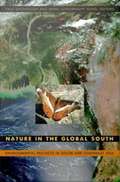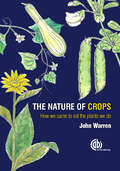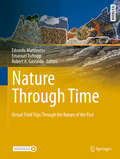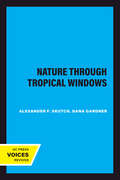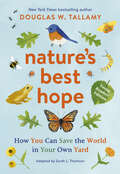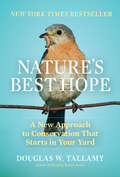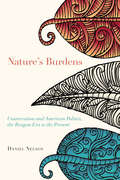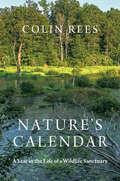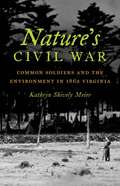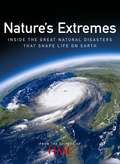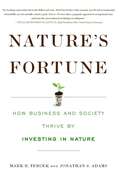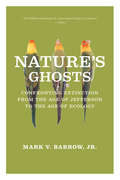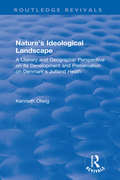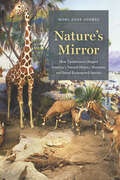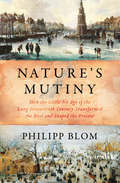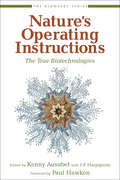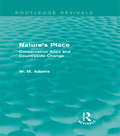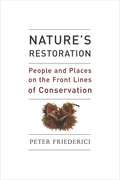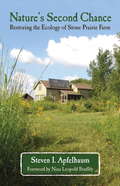- Table View
- List View
Nature in the Built Environment: Global Politico-Economic, Geo-Ecologic and Socio-Historical Perspectives
by Ambe J. NjohA good understanding of the status quo is necessary for the success of efforts to develop and maintain nature in built space. Accordingly, this book conducts an environmental scan of the context of these efforts in global perspective. In particular, it develops and employs a novel environmental scanning model (ESM) designed to rigorously analyze the political, economic, social, technological, ecological, cultural and historical (PESTECH) contexts of initiatives to promote biodiversity in the built environment. The focus is on four specific substantive areas of environmental policy, namely forestry, water, food, and energy. The units of analysis roughly correspond with the major United Nations Environmental Programme (UNEP) regions of the world, including sub-Saharan Africa, Middle-East and North Africa, Asia and the Pacific, Western Europe, North America, and Latin America and the Caribbean.
Nature in the Global South: Environmental Projects in South and Southeast Asia
by Paul Greenough Anna Lowenhaupt TsingA nuanced look at how nature has been culturally constructed in South and Southeast Asia, Nature in the Global South is a major contribution to understandings of the politics and ideologies of environmentalism and development in a postcolonial epoch. Among the many significant paradigms for understanding both the preservation and use of nature in these regions are biological classification, state forest management, tropical ecology, imperial water control, public health, and community-based conservation. Focusing on these and other ways that nature has been shaped and defined, this pathbreaking collection of essays describes projects of exploitation, administration, science, and community protest. With contributors based in anthropology, ecology, sociology, history, and environmental and policy studies, Nature in the Global South features some of the most innovative and influential work being done in the social studies of nature. While some of the essays look at how social and natural landscapes are created, maintained, and transformed by scientists, officials, monks, and farmers, others analyze specific campaigns to eradicate smallpox and save forests, waterways, and animal habitats. In case studies centered in the Philippines, India, Pakistan, Thailand, Indonesia, and South and Southeast Asia as a whole, contributors examine how the tropics, the jungle, tribes, and peasants are understood and transformed; how shifts in colonial ideas about the landscape led to extremely deleterious changes in rural well-being; and how uneasy environmental compromises are forged in the present among rural, urban, and global allies. Contributors: Warwick Anderson Amita Baviskar Peter Brosius Susan Darlington Michael R. Dove Ann Grodzins Gold Paul Greenough Roger Jeffery Nancy Peluso K. Sivaramakrishnan Nandini Sundar Anna Lowenhaupt Tsing Charles Zerner
Nature of Crops, The: How we came to eat the plants we do
by Professor John WarrenHave you ever wondered why we eat wheat, rice, potatoes and cassava? Why we routinely domesticate foodstuffs with the power to kill us, or why we chose almonds over acorns? Answering all these questions and more in a readable and friendly style, this book takes you on a journey through our history with crop plants. Arranged into recurrent themes in plant domestication, this book documents the history and biology of over 50 crops, including cereals, spices, legumes, fruits and cash crops such as chocolate, tobacco and rubber. In The Nature of Crops John Warren reveals: -Why the Egyptians worshipped onions; -Why red-flowering runner beans provide fewer beans than white-flowering; -The inherent dangers of being a pineapple worker; and -Why a bird will always beat you in a chilli pepper eating competition!
Nature through Time: Virtual field trips through the Nature of the past (Springer Textbooks in Earth Sciences, Geography and Environment)
by Edoardo Martinetto Emanuel Tschopp Robert A. GastaldoThis book simulates a historical walk through nature, teaching readers about the biodiversity on Earth in various eras with a focus on past terrestrial environments. Geared towards a student audience, using simple terms and avoiding long complex explanations, the book discusses the plants and animals that lived on land, the evolution of natural systems, and how these biological systems changed over time in geological and paleontological contexts. With easy-to-understand and scientifically accurate and up-to-date information, readers will be guided through major biological events from the Earth's past. The topics in the book represent a broad paleoenvironmental spectrum of interests and educational modules, allowing for virtual visits to rich geological times. Eras and events that are discussed include, but are not limited to, the much varied Quaternary environments, the evolution of plants and animals during the Cenozoic, the rise of angiosperms, vertebrate evolution and ecosystems in the Mesozoic, the Permian mass extinction, the late Paleozoic glaciation, and the origin of the first trees and land plants in the Devonian-Ordovician. With state-of-the art expert scientific instruction on these topics and up-to-date and scientifically accurate illustrations, this book can serve as an international course for students, teachers, and other interested individuals.
Nature through Tropical Windows
by Alexander F. SkutchThis title is part of UC Press's Voices Revived program, which commemorates University of California Press’s mission to seek out and cultivate the brightest minds and give them voice, reach, and impact. Drawing on a backlist dating to 1893, Voices Revived makes high-quality, peer-reviewed scholarship accessible once again using print-on-demand technology. This title was originally published in 1983.
Nature's Allies: Eight Conservationists Who Changed Our World
by Larry NielsenIt's easy to feel powerless in the face of big environmental challenges—but we need inspiration more than ever. With political leaders who deny climate change, species that are fighting for their very survival, and the planet's last places of wilderness growing smaller and smaller, what can a single person do? InNature's Allies, Larry Nielsen uses the stories of conservation pioneers to show that through passion and perseverance, we can each be a positive force for change.In eight engaging and diverse biographies—John Muir, Ding Darling,Aldo Leopold, Rachel Carson, Chico Mendes,Billy Frank Jr., Wangari Maathai, and Gro Harlem Brundtland—we meet individuals who have little in common except that they all made a lasting mark on our world. Some famous and some little known to readers, they spoke out to protect wilderness, wildlife, fisheries, rainforests, and wetlands. They fought for social justice and exposed polluting practices. They marched, wrote books, testified before Congress, performed acts of civil disobedience, and, in one case, were martyred for their defense of nature.Nature's Alliespays tribute to them all as it rallies a new generation of conservationists to follow in their footsteps.These vivid biographies are essential reading for anyone who wants to fight for the environment against today's political opposition. Nature's Allies will inspire students, conservationists, and nature lovers to speak up for nature and show the power of one person to make a difference.
Nature's Best Hope (Young Readers' Edition): How You Can Save the World in Your Own Yard
by Douglas W. TallamyThis middle grade edition of the groundbreaking bestseller by Doug Tallamy will inspire kids to use their backyard to help save the planet. Douglas W. Tallamy awakened thousands of readers to an urgent situation: wildlife populations are in decline because the native plants they depend on are fast disappearing. His solution? Plant more natives. In this middle grade adaptation of the New York Times bestseller Nature's Best Hope, Tallamy outlines his vision for a grassroots approach to conservation that everyone can participate in regardless of age. In Nature's Best Hope (Young Readers' Edition), Tallamy empowers kids to use their own yards to help combat the negative effects of climate change. He does so by breaking down complex concepts into simple terms and real-world examples that kids can easily grasp. Black and white photographs help further clarify concepts. In addition to sharing the science, Tallamy encourages kids to take direct action. Some of these ideas include planting an oak tree (one of the most important tree species) at home. If that&’s too large of a task, he suggests they can plant asters—a beautiful flower whose pollen bees use to feed their young. By helping the next generation see that they have power and agency over our collective future, this empowering book will drive home the positive point that kids are truly nature&’s best hope.
Nature's Best Hope: A New Approach to Conservation that Starts in Your Yard
by Douglas W. Tallamy&“Tallamy lays out all you need to know to participate in one of the great conservation projects of our time. Read it and get started!&” —Elizabeth Kolbert, Pulitzer Prize-winning author of The Sixth Extinction Douglas W. Tallamy&’s first book, Bringing Nature Home, awakened thousands of readers to an urgent situation: wildlife populations are in decline because the native plants they depend on are fast disappearing. His solution? Plant more natives. In this new book, Tallamy takes the next step and outlines his vision for a grassroots approach to conservation. Nature&’s Best Hope shows how homeowners everywhere can turn their yards into conservation corridors that provide wildlife habitats. Because this approach relies on the initiatives of private individuals, it is immune from the whims of government policy. Even more important, it&’s practical, effective, and easy—you will walk away with specific suggestions you can incorporate into your own yard. If you&’re concerned about doing something good for the environment, Nature&’s Best Hope is the blueprint you need. By acting now, you can help preserve our precious wildlife—and the planet—for future generations.
Nature's Burdens: Conservation and American Politics, The Reagan Era to the Present
by Daniel NelsonNature’s Burdens is a political and intellectual history of American natural resource conservation from the 1980s into the twenty-first century—a period of intense political turmoil, shifting priorities among federal policymakers, and changing ideas about the goals of conservation. Telling a story of persistent activism, conflict, and frustration but also of striking achievement, it is an account of how new ideas and policies regarding human relationships to plants, animals, and their surroundings have become vital features of modern environmentalism. In the 1960s and 1970s, Congress embraced the largely dormant movement to preserve distinctive landscapes and the growing demand for outdoor recreation, establishing an unprecedented number of parks, monuments, and recreation areas. The election of Ronald Reagan and a shift to a Republican-controlled Senate brought this activity to an abrupt halt and introduced a period of intense partisanship and legislative gridlock that extends to the present. In this political climate, three developments largely defined the role of conservation in contemporary society: environmental organizations have struggled to defend the legal status quo, private land conservation has become increasingly important, and the emergence of potent scientific voices has promoted the protection of animals and plants and injected a new sense of urgency into the larger cause. These developments mark this period as a distinctive and important chapter in the history of American conservation. Scrupulously researched, scientifically and politically well informed, concise, and accessibly written, Nature’s Burdens is the most comprehensive examination of recent efforts to protect and enhance the natural world. It will be of interest to environmental historians, environmental activists, and any general reader interested in conservation.
Nature's Calendar: A Year in the Life of a Wildlife Sanctuary
by Colin ReesTake an enchanting journey through the shifting seasons in a wildlife sanctuary home to wetland, forest, and grassland and supporting an incredible diversity of plants and animals.Flocks of waterfowl exploding into steely skies above frozen marshland, salamanders creeping across the forest floor to vernal pools, chorusing frogs peeping their ecstasy while warblers crowd budding trees, turtles sunning on floating logs, the ecological engineering of beavers—these are but a few of the sights and sounds marking a year at Jug Bay Wetlands Sanctuary and its neighboring landscapes in Southern Maryland. In an absorbing account of a year in the life of this sanctuary, naturalist Colin Rees invites us to join him as he explores the secrets and wonders of the changing natural world. Alongside the author, we witness spring's avian migrations, quickening of aquatic vegetation, burgeoning of myriad invertebrates, and the assaults of extreme weather conditions. We revel in summertime's proliferation of fish, fowl, and mammals. We become attuned to the shifting climate's impacts on autumnal transitions, and we marvel at amazing feats of biological inventiveness in preparation for winter conditions. Through these visions of the fleeting—and yet enduring—cycles of nature, Rees shares deep insights into the ecological and behavioral dynamics of the natural environment. Enhanced by more than two dozen color plates, the book touches on a wide range of issues, from microbial diversity, bird banding, and butterfly phenology to genetic diversity and habitat fragmentation. It also examines the challenges of conserving these and other natural features in the face of climate change and development pressures. Thoughtful and lyrical, Nature's Calendar speaks to all readers, scientific and lay alike. Fascinating profiles of flora and fauna celebrate the richness and complexity of a unique ecosystem, exploring the entire ecology of this dynamic and delicate area.
Nature's Civil War
by Kathryn Shively MeierIn the Shenandoah Valley and Peninsula Campaigns of 1862, Union and Confederate soldiers faced unfamiliar and harsh environmental conditions--strange terrain, tainted water, swarms of flies and mosquitoes, interminable rain and snow storms, and oppressive heat--which contributed to escalating disease and diminished morale. Using soldiers' letters, diaries, and memoirs, plus a wealth of additional personal accounts, medical sources, newspapers, and government documents, Kathryn Shively Meier reveals how these soldiers strove to maintain their physical and mental health by combating their deadliest enemy--nature.Meier explores how soldiers forged informal networks of health care based on prewar civilian experience and adopted a universal set of self-care habits, including boiling water, altering camp terrain, eradicating insects, supplementing their diets with fruits and vegetables, constructing protective shelters, and most controversially, straggling. In order to improve their health, soldiers periodically had to adjust their ideas of manliness, class values, and race to the circumstances at hand. While self-care often proved superior to relying upon the inchoate military medical infrastructure, commanders chastised soldiers for testing army discipline, ultimately redrawing the boundaries of informal health care.
Nature's Extremes: Inside the Great Natural Disasters That Shape Life on Earth
by Kelly KnauerThe killer tsunami of 2004 and the devastation of Hurricane Katrina remind us of the fragility of man's place on his home planet. Now Time explores the past, present and future of this unpredictable planet, tracing the rise and fall of ancient civilizations, exploring earths most extreme environments and flying with scientists into the wildest of weather systems -- a fascinating look back at the discoveries that changed the world
Nature's Fabric: Leaves in Science and Culture
by David LeeLeaves are all around us—in backyards, cascading from window boxes, even emerging from small cracks in city sidewalks given the slightest glint of sunlight. Perhaps because they are everywhere, it’s easy to overlook the humble leaf, but a close look at them provides one of the most enjoyable ways to connect with the natural world. A lush, incredibly informative tribute to the leaf, Nature’s Fabric offers an introduction to the science of leaves, weaving biology and chemistry with the history of the deep connection we feel with all things growing and green. Leaves come in a staggering variety of textures and shapes: they can be smooth or rough, their edges smooth, lobed, or with tiny teeth. They have adapted to their environments in remarkable, often stunningly beautiful ways—from the leaves of carnivorous plants, which have tiny “trigger hairs” that signal the trap to close, to the impressive defense strategies some leaves have evolved to reduce their consumption. (Recent studies suggest, for example, that some plants can detect chewing vibrations and mobilize potent chemical defenses.) In many cases, we’ve learned from the extraordinary adaptations of leaves, such as the invention of new self-cleaning surfaces inspired by the slippery coating found on leaves. But we owe much more to leaves, and Lee also calls our attention back to the fact that that our very lives—and the lives of all on the planet—depend on them. Not only is foliage is the ultimate source of food for every living thing on land, its capacity to cycle carbon dioxide and oxygen can be considered among evolution’s most important achievements—and one that is critical in mitigating global climate change. Taking readers through major topics like these while not losing sight of the small wonders of nature we see every day—if you’d like to identify a favorite leaf, Lee’s glossary of leaf characteristics means you won’t be left out on a limb—Nature’s Fabric is eminently readable and full of intriguing research, sure to enhance your appreciation for these extraordinary green machines.
Nature's Fortune: How Business and Society Thrive by Investing in Nature
by Jonathan S. Adams Mark R. TercekWhat is nature worth? The answer to this question-which traditionally has been framed in environmental terms-is revolutionizing the way we do business. In Nature’s Fortune, Mark Tercek, CEO of The Nature Conservancy and former investment banker, and science writer Jonathan Adams argue that nature is not only the foundation of human well-being, but also the smartest commercial investment any business or government can make. The forests, floodplains, and oyster reefs often seen simply as raw materials or as obstacles to be cleared in the name of progress are, instead, as important to our future prosperity as technology or law or business innovation. Who invests in nature, and why? What rates of return can it produce? When is protecting nature a good investment? With stories from the South Pacific to the California coast, from the Andes to the Gulf of Mexico and even to New York City, Nature’s Fortune shows how viewing nature as green infrastructure allows for breakthroughs not only in conservation-protecting water supplies; enhancing the health of fisheries; making cities more sustainable, livable and safe; and dealing with unavoidable climate change-but in economic progress, as well. Organizations obviously depend on the environment for key resources-water, trees, and land. But they can also reap substantial commercial benefits in the form of risk mitigation, cost reduction, new investment opportunities, and the protection of assets. Once leaders learn how to account for nature in financial terms, they can incorporate that value into the organization’s decisions and activities, just as habitually as they consider cost, revenue, and ROI. Such a rethinking of "natural capital”-nature as a quantifiable asset-can not only increase profitability, but provide crucial protection against the kinds of climate change-driven phenomena-like devastating drought and hundred-year floods-that are no longer the stuff of speculation. A must-read for business leaders, CEOs, investors, and environmentalists alike, Nature’s Fortune offers an essential guide to the world’s economic-and environmental-well-being.
Nature's Ghosts: Confronting Extinction from the Age of Jefferson to the Age of Ecology
by Mark V. Barrow Jr.A historical narrative of endangered animals and the dedicated individuals who have studied and struggled to protect them, offering an unprecedented view of what we've lost and a stark reminder of the hard work of preservation still ahead.
Nature's Ideological Landscape: A Literary and Geographic Perspective on its Development and Preservation on Denmark's Jutland Heath (Routledge Revivals)
by Kenneth OlwigOriginally published in 1984 Nature’s Ideological Language examines the common ideological roots of environmental reclamation and nature preservation. In the general context of European, British and American historical experience, the Jutland heaths of Denmark are taken as a concrete example for a general critique of European and American policy concerning the use of landscape. Two sets of contradictions are highlighted: ideological and practical between development and preservation; and those between scientific, historical aesthetic and recreational motivation for preservation. The book is based on a study of the Jutland heath from 1750 to the present, focusing on the Danish perception of the area as expressed in literary art and in economic journals, topographies and government reports. Against this background, the development of the modern conception of nature is traced and its ideological implications and planning consequences discussed. As a study of humanistic geography, this book will be of interest to geographers, conservationists and planners.
Nature's Mirror: How Taxidermists Shaped America’s Natural History Museums and Saved Endangered Species
by Mary Anne AndreiIt may be surprising to us now, but the taxidermists who filled the museums, zoos, and aquaria of the twentieth century were also among the first to become aware of the devastating effects of careless human interaction with the natural world. <p><p> Witnessing firsthand the decimation caused by hide hunters, commercial feather collectors, whalers, big game hunters, and poachers, these museum taxidermists recognized the existential threat to critically endangered species and the urgent need to protect them. The compelling exhibits they created—as well as the scientific field work, popular writing, and lobbying they undertook—established a vital leadership role in the early conservation movement for American museums that persists to this day. <p><p> Through their individual research expeditions and collective efforts to arouse demand for environmental protections, this remarkable cohort—including William T. Hornaday, Carl E. Akeley, and several lesser-known colleagues—created our popular understanding of the animal world and its fragile habitats. For generations of museum visitors, they turned the glass of an exhibition case into a window on nature—and a mirror in which to reflect on our responsibility for its conservation.
Nature's Mutiny: How The Little Ice Age Of The Long Seventeenth Century Transformed The West And Shaped The Present
by Philipp BlomAn illuminating work of environmental history that chronicles the great climate crisis of the 1600s, which transformed the social and political fabric of Europe. <P><P> Although hints of a crisis appeared as early as the 1570s, the temperature by the end of the sixteenth century plummeted so drastically that Mediterranean harbors were covered with ice, birds literally dropped out of the sky, and “frost fairs” were erected on a frozen Thames—with kiosks, taverns, and even brothels that become a semi-permanent part of the city. <P><P> Recounting the deep legacy and far-ranging consequences of this “Little Ice Age,” acclaimed historian Philipp Blom reveals how the European landscape had suddenly, but ineradicably, changed by the mid-seventeenth century. While apocalyptic weather patterns destroyed entire harvests and incited mass migrations, they gave rise to the growth of European cities, the emergence of early capitalism, and the vigorous stirrings of the Enlightenment. A timely examination of how a society responds to profound and unexpected change, Nature’s Mutiny will transform the way we think about climate change in the twenty-first century and beyond.
Nature's Operating Instructions
by Paul Hawken Kenny Ausubel J. P. HarpigniesArchiving ancient corn strains to guard against genetic pollution? Coating chainsaw blades with mushroom spores to speed forest regeneration? Growing crops that literally suck heavy metals out of damaged soil? These are not utopian fantasies but proven strategies developed by experts who understand that working with living systems, rather than suppressing them, is the key to creating a sustainable future.For this second volume in Sierra Club Books' Bioneers Series, Bioneers founder Kenny Ausubel has gathered reports from scientific innovators in fields such as biomimicry (mimicking nature to restore environments and transform production processes); "living technologies" that break down toxics biologically; and ecologically sound design for industries and buildings. These are set alongside essays by visionaries like Paul Hawken, Terry Tempest Williams, and Michael Pollan that underscore the urgent need for working in harmony with nature's intelligent design. Unlike the corporatized genetics that claims the name "biotechnology," the true biotechnologies surveyed here illuminate a future of hope by "wedding human ingenuity with the wisdom of the wild," in the words of contributor John Todd. Sector by sector-from energy and agriculture to transportation and land management-this book shows how we can emulate and adapt nature's operating instructions to the benefit of all life on Earth.
Nature's Patchwork Quilt: Understanding Habitats
by Mary Miché Consie PowellJust imagine all of nature - mountains, prairies, oceans, and all - lying on your bed as a patchwork quilt! Take flora and fauna in their unique habitats, fold them up and you have a book, this book. Earth's major habitats are spread before you, ready to be examined. Here in this beautiful package are revealed the key concepts of natural science. This patchwork quilt of nature covers the whole Earth, your home - yours to learn about, to enjoy, to care for, and to love.
Nature's Patchwork Quilt: Understanding Habitats (Into Reading, Read Aloud Module 9 #1)
by Mary Miché Consie PowellNIMAC-sourced textbook <p><p> Just imagine all of nature— mountains, prairies, oceans, and all—lying on your bed as a patchwork quilt! Take flora and fauna in their unique habitats, fold them up and you have a book, this book. Earth's major habitats are spread before you, ready to be examined. Here in this beautiful package are revealed the key concepts of natural science. This patchwork quilt of nature covers the whole Earth, your home—yours to learn about, to enjoy, to care for, and to love.
Nature's Place: Conservation Sites and Countryside Change (Routledge Revivals)
by William M. AdamsNature conservation has become increasingly important in Britain over the last three decades. This title, first published in 1986, deals with the critical issues surrounding nature conservation and wildlife protection. The book is broad in scope, with a focus on the 1981 Wildlife and Countryside Act and its provisions for the protection of wildlife habitats in Sites of Special Scientific Interest (SSSIs). This follows an historical account of habitat loss over the past 200 years and the origins of conservation and site-protection policy. This reissue will be of particular value to professionals, voluntary workers and students with an interest in the origins, developments and practice of nature conservation.
Nature's Restoration: People and Places on the Front Lines of Conservation
by Peter FriedericiAcross America and around the world, people areworking to help nature heal itself. In Bermuda, a mansingle-handedly grows thousands of trees on a smallisland to restore nesting habitat for a rare seabird. InIllinois, legions of volunteers replant prairies in theshadows of freeways. In Virginia, a farmer works tobring back the mighty American chestnut.What drives these individuals? How did their passionscome about, and what are the implications forrestoring the environment? Nature"s Restoration: People and Places on theFront Lines of Conservation is a lyrical look at these and other examplesof ordinary citizens aiming to return sizable tracts of the Americanlandscape to nature, and to health. They"ve found success in preservingrare species, reversing negative ecological trends, and promotinggreater intimacy with nature.Yet the work is far from simple. Restoration projects are often in thenews not only because of the promise they hold, but also because ofthe controversy they provoke. Based on detailed reporting and numerousinterviews, Nature"s Restoration puts us on the front lines ofrestoration to learn how this burgeoning national movement shapesboth places and people.
Nature's Saviours: Celebrity Conservationists in the Television Age
by Graham HugganToday's celebrity conservationists, many of whom made their reputations through television and other visual media, play a major role in drawing public attention to an increasingly threatened world. This book, one of the first to address this contribution, focuses on five key figures: the English naturalist David Attenborough, the French marine adventurer Jacques-Yves Cousteau, the American primatologist Dian Fossey, the Canadian scientist-broadcaster-activist David Suzuki, and the Australian 'crocodile hunter' Steve Irwin. Some of the issues the author addresses include: What is the changing relationship between western conservation and celebrity? How has the spread of television helped shape and mediate this relationship? To what extent can celebrity conservation be seen as part of a global system in which conservation, like celebrity, is big business? The book critically examines the heroic status accorded to the five figures mentioned above, taking in the various discourses – around nature, science, nation, gender – through which they and their work have been presented to us. In doing so, it fills in the cultural, historical and ideological background behind contemporary celebrity conservationism as a popular expression of a chronically endangered world.
Nature's Second Chance: Restoring the Ecology of Stone Prairie Farm
by Steven I. ApfelbaumRenowned conservationist Aldo Leopold once wrote, "A thing is right when it tends to preserve the integrity, stability, and beauty of the biotic community. It is wrong when it does otherwise. "Few have taken Leopold’s vision more to heart than Steven I. Apfelbaum, who has, over the last thirty years, transformed his eighty-acre Stone Prairie Farm in Wisconsin into a biologically diverse ecosystem of prairie, wetland, spring-fed brook, and savanna. In healing his land, Apfelbaum demonstrates how humans might play a starring role in healing the planet.

